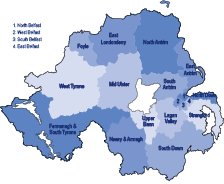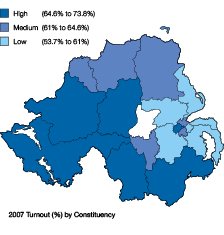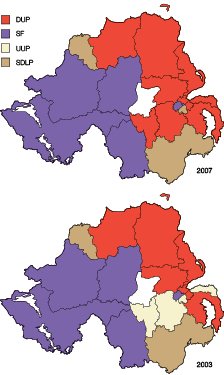Factsheet 8
Elections to the Northern Ireland Assembly
Introduction
The Northern Ireland Assembly was established under the terms of the Belfast Agreement (also known as the Good Friday Agreement) and was first elected on 25 June 1998. Legislative powers and executive authority for the Northern Ireland Government Departments were devolved to the Assembly from 2 December 1999.
The second election to the Assembly was held on 26 November 2003, although the Assembly had been suspended since 14 October 2002 and it remained suspended after this election. The Northern Ireland (St Andrews Agreement) Act 2006 provided for a Transitional Assembly to take part in preparations for the restoration of devolved government, in accordance with the St Andrews Agreement.
This Transitional Assembly helped to create the conditions for a third Assembly election, which took place on 7 March 2007. Restoration took place on 8 May 2007.
The Electoral System
The Single Transferable Vote (STV) system of proportional representation is used to elect Members of the Assembly. This system is also used in the Northern Ireland Local Government and European Parliament elections, and in elections in the Republic of Ireland.
STV has a number of advantages over the simple ‘first past the post’ system used in the Westminster elections:
- It increases voter choice (voters can vote for more than one candidate and can choose between candidates as well as between parties);
- It ensures that more voters have an effect on the outcome (over 80% of all valid votes are used to elect the six Members in each constituency); and
- It ensures an outcome that is more representative of the views of the electorate (a party’s overall share of seats will better reflect their overall share of the vote i.e. voters will be proportionately represented).
The STV system works as follows:
i. Voters in each constituency vote for as many candidates as they wish in order of preference, putting a ‘1’ beside their first choice, a ‘2’ beside their second choice and so on.
ii. Each voting paper is checked to see if it has been correctly filled in and any spoilt papers are removed from the count to give a total valid count. This is the minimum number of votes a candidate must have to be elected.
iii. A quota is calculated for each constituency using the formula:
| Quota = { | total number of valid votes cast in constituency (v) | } + 1 |
| number of seats (s) |
iv. Voting papers are sorted according to first preferences. Any candidate attaining or exceeding the quota is elected.
v. Surplus votes from candidates who exceed the quota are transferred to other candidates. To ensure fairness, all the candidate’s ballots are transferred at a fractional value to second preference candidates.
vi. Candidates with the least number of votes are eliminated and their votes are also transferred to second preference candidates.
vii. This process continues until all available seats have been filled.
This procedure was used to elect six Members in each of the 18 constituencies in the 1998, 2003 and 2007 elections.
The Constituencies
The 18 Westminster parliamentary constituencies are used for the Assembly elections (see map below). Six seats are allocated to each constituency, giving a total of 108 seats. The geographical boundaries for the 18 constituencies have remained unchanged since the first Assembly election in 1998.

The Candidates
A total of 257 candidates stood for the 2007 election, compared with 256 in 2003.
There were 47 female candidates in this election (49 in 2003 and in 1998). The party with the greatest number of female candidates in the 2007 election was the SDLP, with fourteen.
In 2007, of the 108 outgoing MLAs, 91 stood for re-election.
Turnout

The total eligible electorate was 1,107,904 (compared with 1,097,526 in 2003). The total valid vote was 690,313, or 62.3% of the electorate (compared with a turnout of 63.1% in 2003 and 69.9% in 1998).
Turnout for the 2007 election was highest in Mid Ulster (72.3%) and lowest in East Antrim (53.0%).
Results
Party with Highest Share of First Preference Votes in each Constituency

The 2007 Northern Ireland Assembly election left the parties with the following seats:
Democratic Unionist Party |
36 |
| Sinn Fein | 28 |
| Ulster Unionist Party | 18 |
| Social Democratic and Labour Party | 16 |
| Alliance Party of Northern Ireland | 7 |
| Progressive Unionist Party | 1 |
| Green Party | 1 |
| Independent | 1 |

Compared with the 2003 election, the 2007 election resulted in swings in favour of the Democratic Unionist Party (+6 seats), Sinn Fein (+4 seats) and the Alliance Party (+1 seat), while the Green Party acquired its first seat in the Assembly. The Progressive Unionist Party retained the one seat that it had held previously, while the UK Unionist Party lost its only seat. The Ulster Unionist Party lost 9 seats and the Social Democratic and Labour Party, 2 seats.
The Democratic Unionist Party had the highest share of all first preference votes (30.1% - up from 25.7% in 2003), followed by Sinn Fein (26.2% - up from 23.5% in 2003), SDLP (15.2% - down from 17.0% in 2003) and the Ulster Unionist Party (14.9% - down from 22.7% in 2003). The Alliance Party increased its share of the vote from 3.7% in 2003 to 5.2%.
79% of transfers from Unionist voters went to other Unionist party candidates; 12% went to Nationalist party candidates.
64% of transfers from Nationalist voters went to other Nationalist party candidates; 13% went to Unionist party candidates.
Of the 108 MLAs elected in 2007, 29 were new and 18 were women (the same number as elected in 2003).
total number of valid votes cast in constituency (V)
Number of seats (S)
Assembly Information
Public Information Service
Northern Ireland Assembly
Parliament Buildings
Belfast, BT4 3XX
NIA General Enquiries
Tel: +44 (0)28 9052 1333
Fax: +44 (0)28 9052 1980
Email: info@niassembly.gov.uk
